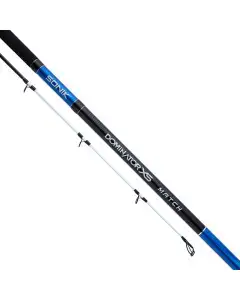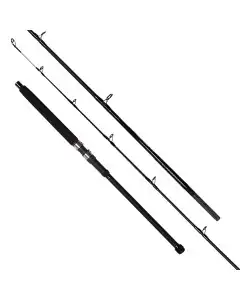This is a demo store. No orders will be fulfilled.
Material Matters: Exploring Sea Fishing Rods

The world of beach angling is vast and varied, with the choice of sea fishing tackle playing a crucial role in an angler's success. Central to this is the fishing rod, a tool that has evolved significantly over the years.
The material of fishing rods for sea fishing is not just a matter of aesthetics or tradition, it directly impacts performance, durability, and the overall fishing experience.
In this article we shall dive deep into the world of sea fishing rods, exploring which rod is best for you and considering everything that goes into making each saltwater rod special.
History of Sea Fishing Rods
Traditionally, sea fishing rods were crafted from natural materials like bamboo or wood, offering a certain level of flexibility and strength. However, as technology advanced, so did the materials used in rod construction, leading to more durable, lightweight, and responsive designs.
What rod should I use for sea fishing?
Beach Rods: Designed specifically for fishing from the beach, beach casters are ideal for beach or shore fishing, especially where casting distance is crucial.
Usually long (often over 12 feet) to help cast bait far out into the sea. They are typically sturdy to handle larger fish and to cast heavy weights.


Boat Rods: Crafted for fishing from a boat, sea fishing boat rods are perfect for deep sea fishing or when fishing directly off a boat in deeper waters.
Shorter in length (around 6 to 8 feet) for better handling on a boat. They are generally robust to handle larger sea fish.
Spinning Rods: Versatile rods primarily used for casting lures or baits, spin rods can be used for a variety of sea fishing scenarios, including from shores or boats, particularly when using lures.
Usually lightweight and range from 5 to 8 feet in length. They have a fast action, which provides good sensitivity and allows for precise lure control.
Surf Rods: Designed for surf fishing, where anglers fish from the shoreline into the surf or just beyond. Ideal for casting long distances from the shore, particularly in rough surf conditions.
Very long (up to 15 feet), to cast bait beyond the breaking waves. They are sturdy to handle the rough surf conditions and strong fish.


Travel Rods: Made for anglers who need portability, telescopic sea fishing rods are suitable for anglers who travel and need a compact option without carrying full-length rods.
Typically designed to break down into shorter sections or to telescope down for easy transport. While they vary in length, sea fishing rods telescopic often compromise a bit on strength and sensitivity for the sake of portability.
What is the difference between a beach rod and a surf rod?
Beach rods are specifically designed for side casting methods, making them ideal for certain fishing styles. Surf rods are additionally suitable for ground casting techniques and even pendulum casting. This makes surf rods more adaptable to various casting styles and fishing conditions.
What type of rod is best for saltwater fishing?
The best type of rod for saltwater fishing is one made from corrosion-resistant materials such as graphite, fibreglass, or a composite of both. Each material offers unique characteristics that cater to different fishing styles and preferences.
Choose a rod with a suitable power and action for your target species and fishing technique. Heavy power rods are ideal for larger fish and rough waters, while lighter rods suit smaller species and calmer conditions.
Fiberglass Rods
Fibreglass rods are known for their durability and strength. They are generally heavier and more robust than other types, making them less prone to breaking. They are often recommended for beginners due to their robustness and ease of use. However, they tend to be heavier and less sensitive compared to their graphite counterparts.
Pros:
+ Durability: Excellent for rough handling, less prone to damage.
+ Affordability: Generally cheaper than other materials.
+ Flexibility: Good for beginners due to their flexibility and ease of use.
Cons:
- Weight: Heavier, which may cause fatigue during long fishing sessions.
- Sensitivity: Less sensitive to light bites compared to graphite or composite rods.
Graphite Rods
Graphite rods are prized for their sensitivity and light weight. They provide better feedback to the angler, making them ideal for detecting subtle bites. They allow anglers to feel even the slightest nibble.
Pros:
+ Sensitivity: Excellent for detecting light bites, ideal for species that bite softly.
+ Lightweight: Easier to handle and less tiring for prolonged use.
+ Stiffness: Provides good hook-setting power.
Cons:
- Fragility: More prone to damage if not handled carefully.
- Cost: Generally more expensive than fibreglass rods.
- Handling: May not be suitable for beginners as they require careful handling.
Composite Rods
Composite rods blend the qualities of fibreglass and graphite. They offer a good balance of sensitivity, strength, and flexibility, making them versatile choices for various sea fishing conditions.
Pros:
+ Versatility: Suitable for various fishing conditions and techniques.
+ Balance: Offers a good mix of sensitivity and strength.
+ Durability: More durable than pure graphite rods.
Cons:
- Weight: Slightly heavier than pure graphite rods.
- Cost: Can be more expensive than single-material rods.
Factors Influencing Material Choice
When choosing a sea fishing rod, consider:
- Fishing Location: Shore rods are longer for distance casting, while boat rods are shorter for better control.
- Target Species: Choose based on the size and strength of the fish.
- Rod Length: Longer rods suit shore fishing; shorter rods are better for boats.
- Personal Preference and Experience: Choose what feels right and matches your skill level.


- Rod Power and Action: Heavy rods for larger fish, light rods for smaller fish. Fast action for sensitivity, slow action for distance casting.
- Material: Graphite for sensitivity, fibreglass for durability, and composite for a balance of both.
- Rod Guides: High-quality, more guides for better casting and strength.
- Handle Material: Cork for grip, foam for comfort.
- Portability: Telescopic or multi-piece rods for travel.
- Budget and Brand: Balance cost with quality and brand reputation.
- Compatibility with Reels and Lines: Match rod with reel and line type.
What is the best length for sea fishing rod?
When selecting the best length for a sea fishing rod, especially for surf fishing, it's important to focus on the casting distance required to reach beyond the breaking waves. For this purpose, rods that are between 10 and 14 feet in length are generally the most effective.
These longer rods enable anglers to cast further out into the water and offer improved line control, both of which are crucial for successful surf fishing.


Rod Action and Material
The action of a rod – how it bends and flexes – is greatly influenced by its material. This aspect is crucial in sea fishing, where the right action can mean the difference between landing a catch and losing it.
Fibreglass Rod Action:
Fiberglass rods are known for their flexibility and durability. They can bend significantly without breaking, making them ideal for beginners or those targeting large fish that require a lot of give in the rod.
Generally, fibreglass rods have a slower action, meaning they bend more easily and over a larger portion of the rod. This makes them less sensitive to smaller bites but excellent for battling larger fish.
Their durability and ability to handle larger fish make fibreglass rods suitable for sea fishing, especially when targeting large species or fishing in rough conditions.
Graphite Rod Action:
Graphite rods are stiffer and more sensitive compared to fiberglass. They transmit vibrations from the line much more effectively, allowing anglers to feel even the smallest nibbles.
Graphite rods usually have a faster action, bending more towards the tip rather than throughout the length of the rod. This provides better sensitivity and a quicker power for setting the hook.
The sensitivity of graphite rods makes them ideal for sea fishing when targeting species that are light biters. They also offer more casting accuracy and distance, which can be crucial in certain sea fishing scenarios.
Composite Rod Action:
Composite rods are made from a blend of fiberglass and graphite, offering a balance between flexibility and sensitivity. These rods can vary in action, depending on the blend. They can offer the durability of fiberglass with some of the sensitivity and stiffness of graphite.
Composite rods are versatile, making them suitable for a wide range of sea fishing conditions and species. They are ideal for anglers who want a mix of durability and sensitivity and often fish in varied conditions.
In sea fishing, the choice of rod material can significantly impact the fishing experience and success. Fiberglass rods are better for rough conditions and larger fish, graphite rods excel in sensitivity and casting precision, and composite rods offer a good balance between the two. The right choice depends on the specific conditions and target species in sea fishing.
What rod is best for beach fishing?
Beach casting rods are generally capable of casting bigger weights and catching bigger fish. Many anglers opt for composite beach rods as they are durable for fishing amongst the cast.


Durability and Maintenance
Choosing the right sea fishing rod involves understanding the durability and maintenance requirements of different materials. Each material – fibreglass, graphite, and composite – offers unique characteristics, influencing their longevity and the care they require.
1. Fiberglass Rods:
- Highly Durable: Fiberglass rods are renowned for their robustness. They can withstand significant bending and stress, making them less prone to breaking under pressure.
- Ideal for Rough Handling: These rods are a great choice for anglers who fish in challenging conditions or are less meticulous with their gear, as they can endure rough handling.
2. Graphite Rods:
- Sensitive but Fragile: While graphite rods offer superior sensitivity and stiffness, they are more fragile compared to fibreglass. They can crack or break if mishandled.
- Requires Careful Use: These rods are best for experienced anglers who can handle and store them with care, especially to protect the delicate tip section.
3. Composite Rods:
- Balanced Durability: Composite rods blend the qualities of fibreglass and graphite, offering moderate durability. They're less robust than pure fibreglass but more resilient than pure graphite.
- Versatile Use: They strike a balance between toughness and sensitivity, suitable for varied fishing conditions and handling styles.
Maintenance Tips for Sea Fishing Rods
Fibreglass Rods: Wash with fresh water after each use, especially when used in saltwater, to prevent corrosion and salt buildup. Store in a cool, dry place away from direct sunlight to prevent material degradation.
Graphite Rods: Handle with Care. Avoid hitting the rod against hard surfaces and use a protective tube for transportation. Check for Damage by regularly inspecting for nicks or cracks, especially near the joints and tips. Even small damages can lead to breakage.
Composite Rods: Follow maintenance steps suitable for both fibreglass and graphite. Pay attention to cleaning and careful handling. Due to their mixed composition, regular inspections for signs of wear and tear are crucial.


For all sea rods:
- Lubricate Moving Parts: Keep reel seats and guides well-lubricated to ensure smooth operation.
- Avoid Extreme Temperatures: Extreme heat or cold can affect the rod’s performance and longevity.
- Proper Storage: When not in use, store rods vertically or in racks designed to prevent bending or warping.
Understanding and adhering to these durability and maintenance guidelines can greatly extend the life of your sea fishing rods, ensuring many successful and enjoyable fishing trips.
Cost Considerations Buying a Sea Rod
The cost of sea fishing rods varies widely based on the materials used. It's important to balance initial investment with expected lifespan and performance to find the best value.
How much does a sea fishing rod cost?
Budget Options: For casual or beginner anglers, there are cost-effective rods available, typically priced from £15 to £80. These rods are basic but suitable for occasional use.
Mid-Range Rods: Aimed at more regular anglers, these rods, costing between £80 and £250, offer a good balance of quality and price, featuring better materials and craftsmanship.
High-End Rods: Premium rods, which can cost from £250 to over £600, are designed for top performance and durability, appealing to professional or very dedicated anglers.
Investing in a Rod for Saltwater Fishing
- Durability: Higher-priced rods often provide greater longevity, particularly important for the often challenging sea conditions around the UK.
- Performance: Investing more can lead to enhanced sensitivity, strength, and an overall improved fishing experience.
- Cost-Performance Balance: Weigh the initial investment against expected lifespan and performance. Mid-range rods often represent the best value, offering solid performance without a high price tag.
- Personal Usage: Your fishing frequency and the typical conditions you face should guide your decision. Occasional fishermen might be well-served by budget-friendly rods, while frequent anglers might benefit from investing in more expensive equipment.
Do I need a different rod for sea fishing?
If you are planning to use standard fishing rod to save money, it may be worth considering otherwise. A specialized rod for sea fishing is generally recommended due to the unique challenges of the marine environment.
Sea fishing rods are constructed to withstand the corrosive nature of saltwater and are made with materials that resist rust and corrosion. They are also built to handle the larger and stronger fish typically found in the sea, providing the necessary strength and durability.
Additionally, sea fishing often requires casting your line farther, and these rods are designed for longer casting distances. The action of a sea fishing rod is tailored to the types of lures, baits, and techniques used in saltwater, and they vary to cater to different sizes and species of sea fish. This specialization ensures that anglers have the right equipment for the best experience and success in saltwater fishing.
Expert Opinions on Sea Fishing Rods
Professional anglers often share insights on material choice, drawing from their extensive experience. Phil Spinks has tested out many a sea fishing rod for ADTV.
Advancements in Rod Technology
The future of sea fishing rod construction is exciting, with new materials and designs continually being developed. Innovations in material science promise rods that are even lighter, stronger, and more responsive, further enhancing the fishing experience.
In conclusion, the material of a sea fishing rod plays a pivotal role in its performance and suitability for different fishing conditions and styles. From the robustness of fiberglass to the sensitivity of graphite, and the balanced nature of composite rods, each material offers unique advantages.
Understanding these differences is key to choosing the right rod for your sea fishing adventures.
FAQs on Sea Fishing Rods
What rod should I use for sea fishing?
For sea fishing, choose a rod based on the specific type of sea fishing you're doing. For shore or surf fishing, opt for a longer rod (around 3 to 4 metres) for better casting distance. For boat fishing, a shorter, sturdier rod (1.8 to 2.4 metres) is preferable for better control. Look for rods made from durable, corrosion-resistant materials like graphite or fibreglass.
What is the best length for a sea fishing rod?
The best length for a sea fishing rod varies with the fishing method. For surfcasting from the shore, rods between 3 to 4 metres are ideal for long-distance casting. For boat fishing, shorter rods around 1.8 to 2.4 metres offer better handling and control. The choice also depends on personal preference and the physical environment you're fishing in.
Can I use a carp rod for sea fishing?
Sea fishing rods differ from ordinary or freshwater fishing rods in several key aspects, tailored to meet the unique challenges of the marine environment. They are built to withstand the corrosive saltwater environment, as well as the strength and size of sea fish. Freshwater rods are usually shorter with lower power ratings, as they are designed for smaller species.
What size rod is best for beach casting?
While some anglers may opt for a 15-foot rod, particularly when dealing with rough surf conditions, a 14-foot rod is often sufficient for achieving the necessary casting distance while maintaining ease of handling. This length provides a good balance between casting distance and control, especially in surfcasting scenarios.
What size rod for saltwater pier fishing?
For saltwater pier fishing, a rod between 7 to 10 feet is ideal. This length offers a good balance of casting ability and control for fishing from a pier.
What weight rod for saltwater?
For saltwater fishing, rod weight varies with the type of fishing and target species. Light to medium rods (8-20 lb test) are suitable for inshore fishing, while heavier rods (20-50 lb test or more) are needed for offshore or larger game fishing.




